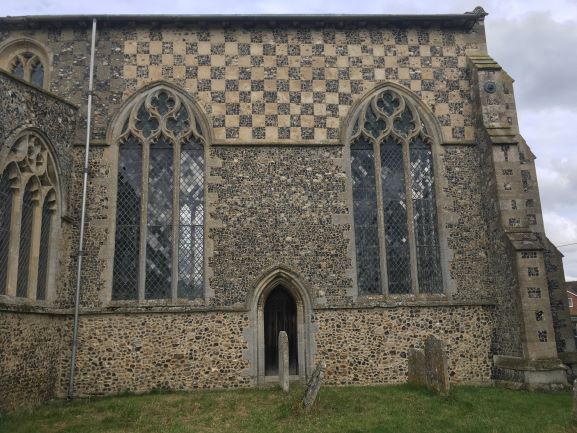Great Ellingham Parish Church of St James
1935 Archaeologists’ Tour
A report of an archaeologists’ tour published in the Yarmouth Independent on the 18th May, 1935, caught my eye.
Amongst the three churches visited in the Wymondham District was St James’s at Great Ellingham. A comment made by Mr E J Tench FIBA particularly grabbed my attention. He was reported to have said of Great Ellingham Church that “it had no history”. However, the statement was qualified by the addition of “at the least, he could find no records of it.”
Nevertheless, the article went on to say that the church dates back to the reign of Edward I, Edward II and Edward III – a time between 1272 and 1377.
Mr Tench is also reported to have said that the church “seemed to have been built at one time, although it probably took a hundred years” (presumably to complete).
List of Rectors & Vicars
Blomefield’s History of the County of Norfolk (1805) provides a list of the Rectors and Vicars of the church of St James the Apostle, Great Ellingham. The list begins with an entry of 1312 when Henry de Brom, priest, was instituted to the Rectory of the church at the presentation of Robert De Elyngham.
Domesday Book
The Domesday Book of 1086 lists (Great Ellingham) under three owners (three parts). There is reference to one church as well as church lands. The three parts consequently became the three manors.
1979 Reverend D H Elton’s Pamphlet
Some 40 years after Mr Tench’s visit to the church, the then Rector, the Reverend D H Elton, compiled a brief History of St James’s Church in July, 1979 (a copy of which I am fortunate to have). The Reverend Elton’s sources were ‘History of Norfolk – Blomefield and The Church of Saint James, Great Ellingham, a pamphlet complied about 1905 by Edwin J Tench.’
It appears to me that the date given by the Reverend Elton for the pamphlet compiled by Edwin J Tench is erroneous. It should read ‘1935’ and not ‘1905’.
The Reverend Elton says there is no mention of a church in the Domesday Book. He also wrote that the list of Rectors given by Blomefield begins at 1312. The Rector also presumed that prior to the present church building, there may have been a ‘simple chapel’. However, he goes on to say that “no trace of it [i.e. any earlier church or chapel] has been found in the present structure, which has been built in the style of the early 14th century.” He also comments that “There is little record of the actual building of the church”.
Church of St James showing some of the chequer work
Pevsner & Wilson’s book (1999) describes St James as ‘essentially an early C14 church’. Amongst many other interesting facts, the book mentions the chequer flushwork.
Conclusion
Despite Tench’s comment in 1935 that St James’s Church ‘had no history’, this wonderful church certainly has a history.
From its beginnings in the early 14th century to today in the 21st century, this church has been the focal point of the community. It will have witnessed the comings and goings of generations of the many families who lived in the village over the centuries. It is possible that some of the families whose names appear in the parish registers starting in 1653, had ancestors living in the village centuries earlier. Some of these family names can also be traced forward to today.
Some 40 years after the Reverend Elton produced his pamphlet on the history of the church, Tina Moon has produced an interesting and detailed history of St James’s Church which you can read here
Sources:
Francis Blomefield, ‘Hundred of Shropham: Great Elingham’, in An Essay Towards A Topographical History of the County of Norfolk: Volume 1 (London, 1805), pp. 482-490. British History Online http://www.british-history.ac.uk/topographical-hist-norfolk/vol1/pp482-490 [accessed 23 September 2021].
Pevsner, N and Wilson, W. 1999. Norfolk 2: North-West and South. The Buildings of England. 2nd Edition. pp 365-366
Yarmouth Independent. Saturday 18th May 1935. Viewed via https://www.britishnewspaperarchive.co.uk 23 September 2021
D.H.E. July 1979. Great Ellingham – St James Church

